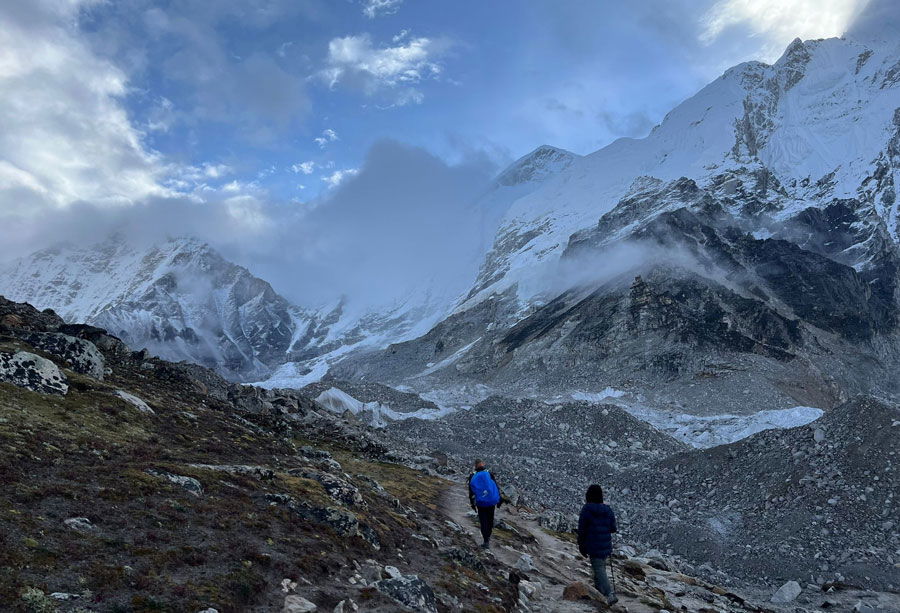How Long to Trek Everest Base Camp: Discover itinerary, distance and tips
Everest Base Camp—just the name sparks a sense of awe and adventure. It’s one of those iconic treks that many dream of, but before setting out, one key question always comes up: how long to trek Everest Base Camp with distance? It’s not just about putting one foot in front of the other—it’s about understanding what you’re stepping into.
Planning a trek to the foot of the world’s highest mountain isn’t just about walking—it’s about preparing your body, your time, and your mindset. In this guide, we’ll walk through how many days you need, what influences that duration, and what you should consider before lacing up those boots.

Table of Contents
- Overview of the Everest Base Camp Trek
- Where Does the Trek Start and End?
- How Many Days to Trek Everest Base Camp?
- Total Distance Covered in the Trek
- Daily Walking Distance and Hours
- Acclimatization Days: Why They Matter
- Sample 12-Day Everest Base Camp Trek Itinerary
- Alternative Itineraries: Shorter or Longer Options
- Physical Fitness Requirements
- Challenges That Affect Trek Duration
- Altitude Sickness and Its Impact on Trekking Time
- Best Time to Trek for Better Timing and Safety
- Packing Smart to Stay Light and Fast
- Do Guided Tours Save Time?
- Final Thoughts on Planning Your Trek
- FAQs
Overview of the Everest Base Camp Trek
The Everest Base Camp Trek (EBC Trek) is one of the world’s most iconic adventures. You’re not summiting Everest itself, but reaching the foot of this mighty mountain at 5,364 meters (17,598 ft) is no small feat.
Along the way, you’ll pass through Sherpa villages, Buddhist monasteries, and awe-inspiring Himalayan landscapes. But the big question remains—how long does it take and what’s the distance covered?
Where Does the Trek Start and End?
The traditional route starts from Lukla, a small airstrip town accessible by a 30-40 minute flight from Kathmandu, Nepal. The trek ends at Everest Base Camp and typically returns to Lukla on foot.
Start Point: Lukla (2,860 meters)
End Point: Everest Base Camp (5,364 meters)
Return Point: Back to Lukla
Think of it as a round-trip journey through the Himalayas.
How Many Days to Trek Everest Base Camp?
A standard EBC trek takes about 12 to 14 days round-trip. That includes:
8–9 days to reach Base Camp
3–4 days to return
2 rest (acclimatization) days built in
So, if you’re not rushing and want to enjoy the journey safely, plan for 12 days minimum.
Total Distance Covered in the Trek
The total trekking distance to and from Everest Base Camp is roughly 130 kilometers (81 miles).
Lukla to EBC: ~65 km
EBC to Lukla (return): ~65 km
It might not sound too long, but at high altitude, every kilometer feels like three!
Daily Walking Distance and Hours
Here’s a breakdown of what your days may look like:
Daily Distance: 10–15 kilometers (6–9 miles)
Daily Time on Trail: 5–7 hours
Some days are easier, and some (like the climb to Namche Bazaar or the final push to Base Camp) are more strenuous.
Think of it like doing a moderate hike every day—but with less oxygen.
Acclimatization Days: Why They Matter
To avoid altitude sickness, two important acclimatization stops are usually included:
Namche Bazaar (3,440m) – Day 2 or 3
Dingboche (4,410m) – Day 5 or 6
These are not rest days where you sleep in. You do short hikes to higher altitudes during the day and return to sleep at lower altitudes—“climb high, sleep low.”
Skipping these? Not recommended. It might save time, but it risks your health.
Sample 12-Day Everest Base Camp Trek Itinerary
Here’s a typical itinerary that balances distance, rest, and safety:
| Day | Route | Distance |
| Day 1 | Fly to Lukla & trek to Phakding | 8 km |
| Day 2 | Phakding to Namche Bazaar | 10 km |
| Day 3 | Acclimatization in Namche | 3–5 km (side hike) |
| Day 4 | Namche to Tengboche | 10 km |
| Day 5 | Tengboche to Dingboche | 11 km |
| Day 6 | Acclimatization in Dingboche | 3–4 km (side hike) |
| Day 7 | Dingboche to Lobuche | 12 km |
| Day 8 | Lobuche to Gorak Shep, visit EBC | 15 km |
| Day 9 | Hike Kala Patthar, return to Pheriche | 13 km |
| Day 10 | Pheriche to Namche | 20 km |
| Day 11 | Namche to Lukla | 18 km |
| Day 12 | Fly back to Kathmandu | — |
Alternative Itineraries: Shorter or Longer Options
Shorter Option (10 Days):
Skip acclimatization or fly out by helicopter from Base Camp. Not advised unless you’re very experienced.
Longer Option (15–20 Days):
Add side trips to Gokyo Lakes, Chola Pass, or Thame. Great if you want more scenery and fewer crowds.
Choose based on your fitness, time, and goals.
Physical Fitness Requirements
You don’t need to be an athlete, but you should be:
Able to walk 6-7 hours daily
Comfortable with uphill/downhill terrain
Used to hiking with a light backpack
Training tip: Start walking or hiking a month before your trip. Add a weighted backpack, and walk on stairs or inclines.
Challenges That Affect Trek Duration
Several factors can change how long your trek takes:
Weather delays (especially flights to/from Lukla)
Altitude sickness
Injury or exhaustion
Personal pace or fitness
That’s why you should keep 1–2 buffer days in your itinerary.
Altitude Sickness and Its Impact on Trekking Time
Altitude sickness is real and affects many trekkers. Symptoms can slow you down or force you to descend.
Common signs:
Headache
Nausea
Dizziness
Fatigue
Taking it slow and drinking water helps. In severe cases, you must descend, which adds days or ends the trek early.
Best Time to Trek for Better Timing and Safety
The ideal trekking seasons are:
Spring (March to May) – Warm, clear skies
Autumn (September to November) – Stable weather, best views
Monsoon (June to August) = slippery trails and leeches
Winter (December to February) = snow and extreme cold
Trekking in ideal seasons keeps you on schedule and safe.
Packing Smart to Stay Light and Fast
Packing light = faster, easier trek.
Must-haves:
Broken-in hiking boots
Lightweight clothing layers
Warm jacket and sleeping bag
Refillable water bottle
Sunscreen and sunglasses
Too much weight will slow you down. Aim for under 10kg in your daypack.
Do Guided Tours Save Time?
Yes. Guided tours can:
Handle logistics
Help you pace the trek better
Offer support in emergencies
Provide local knowledge and insights
While solo trekking is possible, going with a guide and porter makes the journey smoother and safer—especially if you’re short on time or new to high-altitude hiking.
Final Thoughts on Planning Your Trek
So, how long to trek Everest Base Camp with distance?
Plan for:
12–14 days total
130 km round-trip
Average 6 hours/day of hiking
Remember, it’s not a race. Enjoy every moment—the culture, views, and personal growth that come with each step.
Like any great story, it’s not just about the destination—it’s about the journey.
FAQs
1. Can I complete the Everest Base Camp trek in under 10 days?
Technically, yes—but it’s risky. You’ll need to skip acclimatization days or fly out from Base Camp, increasing the chance of altitude sickness.
2. How far do you walk each day on the Everest Base Camp trek?
You typically walk 10 to 15 kilometers (6 to 9 miles) daily, which takes around 5 to 7 hours depending on terrain and altitude.
3. Is the Everest Base Camp trek suitable for beginners?
Yes, with the right preparation. You don’t need technical skills, but physical fitness, mental resilience, and gradual pacing are essential.
4. What’s the total distance to and from Everest Base Camp?
The total distance is approximately 130 kilometers (81 miles) round-trip from Lukla to Base Camp and back.
5. What’s the best time of year to trek Everest Base Camp quickly and safely?
Spring (March–May) and Autumn (September–November) offer the best weather, fewer delays, and safer trails—helping you stay on schedule.




